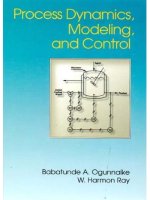scale-up in chemical engineering, 2nd edition, 2006
Bạn đang xem bản rút gọn của tài liệu. Xem và tải ngay bản đầy đủ của tài liệu tại đây (2.17 MB, 277 trang )
Marko Zlokarnik
Scale-Up in Chemical
Engineering
Scale-Up in Chemical Engineering. 2
nd
Edition. M. Zlokarnik
Copyright 2006 WILEY-VCH Verlag GmbH & Co. KGaA, Weinheim
ISBN: 3-527-31421-0
Related Titles
Pietsch, W.
Agglomeration in Industry
Occurance and Applications
2005, ISBN 3-527-30582-3
North American Mixing Forum
Handbook of Industrial Mixing
Science and Practice
2003, ISBN 0-471-26919-0
Rauch, J. (Ed.)
Multiproduct Plants
2003, ISBN 3-527-29570-4
Belfiore, L. A.
Transport Phenomena for
Chemical Reactor Design
2003, ISBN 0-471-20275-4
Sundmacher, K., Kienle, A. (Ed.)
Reactive Distillation
Status and Future Directions
2003, ISBN 3-527-30579-3
Sanchez Marcano, J. G., Tsotsis, T. T.
Catalytic Membranes and
Membrane Reactors
2002, ISBN 3-527-30277-8
Klefenz, H.
Industrial Pharmaceutical
Biotechnology
2002, ISBN 3-527-29995-5
Koolen, J. L. A.
Design of Simple and Robust
Process Plants
2001, ISBN 3-527-29784-7
Marko Zlokarnik
Scale-Up in Chemical Engineering
Second, Completely Revised and Extended Edition
Author
Prof. Dr Ing. Marko Zlokarnik
Grillparzerstr. 58
8010 Graz
Austria
E-Mail:
1
st
Edition 2002
2
nd
, Completely Revised and Extended Edition 2006
&
All books published by Wiley-VCH are carefully
produced. Nevertheless, author and publisher do
not warrant the information contained in these
books, including this book, to be free of errors.
Readers are advised to keep in mind that statements,
data, illustrations, procedural details or other items
may inadvertently be inaccurate.
Library of Congress Card No.: applied for
British Library Cataloguing-in-Publication Data
A catalogue record for this book is available
from the British Library.
Bibliographic information published by
Die Deutsche Bibliothek
Die Deutsche Bibliothek lists this publication
in the Deutsche Nationalbibliografie; detailed
bibliographic data is available in the Internet at
<>.
2006 WILEY-VCH Verlag GmbH & Co. KGaA,
Weinheim
All rights reserved (including those of translation
into other languages). No part of this book may be
reproduced in any form – nor transmitted or trans-
lated into machine language without written
permission from the publishers. Registered
names, trademarks, etc. used in this book,
even when not specifically marked as such,
are not to be considered unprotected by law.
Printed in the Federal Republic of Germany.
Printed on acid-free paper.
Typesetting Kühn & Weyh, Satz und Medien,
Freiburg
Printing Betzdruck GmbH, Darmstadt
Bookbinding Litges & Dopf Buchbinderei GmbH,
Heppenheim
Cover Design aktivComm, Weinheim
Front Cover Painting by Ms. Constance Voß, Graz
2005
ISBN-13: 978-3-527-31421-5
ISBN-10: 3-527-31421-0
This book is dedicated to my friend and teacher
Dr. phil. Dr Ing. h.c. Juri Pawlowski
VII
Preface to the 1st Edition XIII
Preface to the 2nd Edition XV
Symbols XVII
1 Introduction 1
2 Dimensional Analysis 3
2.1 The Fundamental Principle 3
2.2 What is a Dimension? 3
2.3 What is a Physical Quantity? 3
2.4 Base and Derived Quantities, Dimensional Constants 4
2.5 Dimensional Systems 5
2.6 Dimensional Homogeneity of a Physical Content 7
Example 1: What determines the period of oscillation of a pendulum? 7
Example 2: What determines the duration of fall h of a body in a homogeneous
gravitational field (Law of Free Fall)? What determines the speed v
of a liquid discharge out of a vessel with an opening? (Torricelli’s
formula)
9
Example 3: Correlation between meat size and roasting time 12
2.7 The Pi Theorem 14
3 Generation of Pi-sets by Matrix Transformation 17
Example 4: The pressure drop of a homogeneous fluid in a straight, smooth pipe
(ignoring the inlet effects)
17
4 Scale Invariance of the Pi-space – the Foundation of the Scale-up 25
Example 5: Heat transfer from a heated wire to an air stream 27
Contents
Scale-Up in Chemical Engineering. 2
nd
Edition. M. Zlokarnik
Copyright 2006 WILEY-VCH Verlag GmbH & Co. KGaA, Weinheim
ISBN: 3-527-31421-0
VIII
5 Important Tips Concerning the Compilation of the Problem Relevance
List
31
5.1 Treatment of Universal Physical Constants 31
5.2 Introduction of Intermediate Quantities 31
Example 6: Homogenization of liquid mixtures with different densities and
viscosities
33
Example 7: Dissolved air flotation process 34
6 Important Aspects Concerning the Scale-up 39
6.1 Scale-up Procedure for Unavailability of Model Material Systems 39
Example 8: Scale-up of mechanical foam breakers 39
6.2 Scale-up Under Conditions of Partial Similarity 42
Example 9: Drag resistance of a ship’s hull 43
Example 10: Rules of thumb for scaling up chemical reactors: Volume-related
mixing power and the superficial velocity as design criteria for mixing
vessels and bubble columns
47
7 Preliminary Summary of the Scale-up Essentials 51
7.1 The Advantages of Using Dimensional Analysis 51
7.2 Scope of Applicability of Dimensional Analysis 52
7.3 Experimental Techniques for Scale-up 53
7.4 Carrying out Experiments Under Changes of Scale 54
8 Treatment of Physical Properties by Dimensional Analysis 57
8.1 Why is this Consideration Important? 57
8.2 Dimensionless Representation of a Material Function 59
Example 11: Standard representation of the temperature dependence of the viscos-
ity
59
Example 12: Standard representation of the temperature dependence of den-
sity
63
Example 13: Standard representation of the particle strength for different materi-
als in dependence on the particle diameter
64
Example 14: Drying a wet polymeric mass. Reference-invariant representation of
the material function D(T, F)
66
8.3 Reference-invariant Representation of a Material Function 68
8.4 Pi-space for Variable Physical Properties 69
Example 15: Consideration of the dependence l(T) using the l
w
/l term 70
Example 16: Consideration of the dependence (T) by the Grashof number Gr 72
8.5 Rheological Standardization Functions and Process Equations in
Non-Newtonian Fluids
72
8.5.1 Rheological Standardization Functions 73
8.5.1.1 Flow Behavior of Non-Newtonian Pseudoplastic Fluids 73
8.5.1.2 Flow Behavior of Non-Newtonian Viscoelastic Fluids 76
8.5.1.3 Dimensional-analytical Discussion of Viscoelastic fluids 78
8.5.1.4 Elaboration of Rheological Standardization Functions 80
Contents
IX
Example 17: Dimensional-analytical treatment of Weissenberg’s phenomenon –
Instructions for a PhD thesis
81
8.5.2 Process Equations for Non-Newtonian Fluids 85
8.5.2.1 Concept of the Effective Viscosity l
eff
According to Metzner–Otto 86
8.5.2.2 Process Equations for Mechanical Processes with Non-Newtonian
Fluids
87
Example 18: Power characteristics of a stirrer 87
Example 19: Homogenization characteristics of a stirrer 90
8.5.2.3 Process Equations for Thermal Processes in Association with
Non-Newtonian Fluids
91
8.4.2.4 Scale-up in Processes with Non-Newtonian Fluids 91
9 Reduction of the Pi-space 93
9.1 The Rayleigh – Riabouchinsky Controversy 93
Example 20: Dimensional-analytical treatment of Boussinesq’s problem 95
Example 21: Heat transfer characteristic of a stirring vessel 97
10 Typical Problems and Mistakes in the Use of Dimensional Analysis 101
10.1 Model Scale and Flow Conditions – Scale-up and Miniplants 101
10.1.1 The Size of the Laboratory Device and Fluid Dynamics 102
10.1.2 The Size of the Laboratory Device and the Pi-space 103
10.1.3 Micro and Macro Mixing 104
10.1.4 Micro Mixing and the Selectivity of Complex Chemical
Reactions
105
10.1.5 Mini and Micro Plants from the Viewpoint of Scale-up 105
10.2 Unsatisfactory Sensitivity of the Target Quantity 106
10.2.1 Mixing Time h 106
10.2.2 Complete Suspension of Solids According to the 1-s Criterion 106
10.3 Model Scale and the Accuracy of Measurement 107
10.3.1 Determination of the Stirrer Power 108
10.3.2 Mass Transfer in Surface Aeration 108
10.4 Complete Recording of the Pi-set by Experiment 109
10.5 Correct Procedure in the Application of Dimensional Analysis 111
10.5.1 Preparation of Model Experiments 111
10.5.2 Execution of Model Experiments 111
10.5.3 Evaluation of Test Experiments 111
11 Optimization of Process Conditions by
Combining Process Characteristics
113
Example 22: Determination of stirring conditions in order to carry out a
homogenization process with minimum mixing work
113
Example 23: Process characteristics of a self-aspirating hollow stirrer and the deter-
mination of its optimum process conditions
118
Example 24: Optimization of stirrers for the maximum removal of reaction
heat
121
Contents
12 Selected Examples of the Dimensional-analytical Treatment of Processes
in the Field of Mechanical Unit Operations
125
Introductory Remark 125
Example 25: Power consumption in a gassed liquid. Design data for stirrers and
model experiments for scaling up
125
Example 26: Scale-up of mixers for mixing of solids 131
Example 27: Conveying characteristics of single-screw machines 135
Example 28: Dimensional-analytical treatment of liquid atomization 140
Example 29: The hanging film phenomenon 143
Example 30: The production of liquid/liquid emulsions 146
Example 31: Fine grinding of solids in stirred media mills 150
Example 32: Scale-up of flotation cells for waste water purification 156
Example 33: Description of the temporal course of spin drying in centrifugal
filters
163
Example 34: Description of particle separation by means of inertial forces 166
Example 35: Gas hold-up in bubble columns 170
Example 36: Dimensional analysis of the tableting process 174
13 Selected Examples of the Dimensional-analytical Treatment of Processes
in the Field of Thermal Unit Operations
181
13.1 Introductory Remarks 181
Example 37: Steady-state heat transfer in mixing vessels 182
Example 38: Steady-state heat transfer in pipes 184
Example 39 Steady-state heat transfer in bubble columns 185
13.2 Foundations of the Mass Transfer in a Gas/Liquid (G/L) System 189
A short introduction to Examples 40, 41 and 42 189
Example 40: Mass transfer in surface aeration 191
Example 41: Mass transfer in volume aeration in mixing vessels 193
Example 42: Mass transfer in the G/L system in bubble columns with injectors as
gas distributors. Otimization of the process conditions with respect to
the efficiency of the oxygen uptake E ” G/RP
196
13.3 Coalescence in the Gas/Liquid System 203
Example 43: Scaling up of dryers 205
14 Selected Examples for the Dimensional-analytical Treatment of Processes
in the Field of Chemical Unit Operations
211
Introductory Remark 211
Example 44: Continuous chemical reaction process in a tubular reactor 212
Example 45: Description of the mass and heat transfer in solid-catalyzed gas
reactions by dimensional analysis
218
Example 46: Scale-up of reactors for catalytic processes in the petrochemical
industry
226
Example 47: Dimensioning of a tubular reactor, equipped with a mixing nozzle,
designed for carrying out competitive-consecutive reactions
229
ContentsX
Example 48: Mass transfer limitation of the reaction rate of fast chemical reactions
in the heterogeneous material gas/liquid system
233
15 Selected Examples for the Dimensional-analytical Treatment of Processes
whithin the Living World
237
Introductory Remark 237
Example 49: The consideration of rowing from the viewpoint of dimensional
analysis
238
Example 50: Why most animals swim beneath the water surface 240
Example 51: Walking on the Moon 241
Example 52: Walking and jumping on water 244
Example 53: What makes sap ascend up a tree? 245
16 Brief Historic Survey on Dimensional Analysis and Scale-up 247
16.1 Historic Development of Dimensional Analysis 247
16.2 Historic Development of Scale-up 250
17 Exercises on Scale-up and Solutions 253
17.1 Exercises 253
17.2 Solutions 256
18 List of important, named pi-numbers 259
19 References 261
Index 269
Contents XI
XIII
In this day and age, chemical engineers are faced with many research and design
problems which are so complicated that they cannot be solved by numerical
mathematics. In this context, one only has to think of processes involving fluids
with temperature-dependent physical properties or non-Newtonian flow behavior.
Fluid mechanics in heterogeneous physical systems exhibiting coalescence phe-
nomena or foaming, also demonstrate this problem. The scaling up of equipment
needed for dealing with such physical systems often presents serious hurdles
which can frequently be overcome only with the aid of partial similarity.
In general, the university graduate has not been adequately trained to deal with
such problems. On the one hand, treatises on dimensional analysis, the theory of
similarity and scale-up methods included in common, “run of the mill” textbooks
on chemical engineering are out of date. In addition, they are seldom written in a
manner that would popularize these methods. On the other hand, there is no
motivation for this type of research at universities since, as a rule, they are not
confronted with scale-up tasks and are therefore not equipped with the necessary
apparatus on the bench-scale.
All of these points give the totally wrong impression that the methods referred
to are – at most – of only marginal importance in practical chemical engineering,
because otherwise they would have been dealt with in greater depth at university
level!
The aim of this book is to remedy this deficiency. It presents dimensional analy-
sis – this being the only secure foundation for scale-up – in such a way that it can
be immediately and easily understood, even without a mathematical background.
Due to the increasing importance of biotechnology, which employs non-Newto-
nian fluids far more frequently than the chemical industry does, variable physical
properties (e.g., temperature dependence, shear-dependence of viscosity) are treat-
ed in detail. It must be kept in mind that in scaling up such processes, apart from
the geometrical and process-related similarity, the physical similarity also has to
be considered.
The theoretical foundations of dimensional analysis and of scale-up are presen-
ted and discussed in the first half of this book. This theoretical framework is dem-
onstrated by twenty examples, all of which deal with interesting engineering prob-
lems taken from current practice.
Preface to the 1st Edition
Scale-Up in Chemical Engineering. 2
nd
Edition. M. Zlokarnik
Copyright 2006 WILEY-VCH Verlag GmbH & Co. KGaA, Weinheim
ISBN: 3-527-31421-0
XIV
The second half of this book deals with the integral dimensional-analytical
treatment of problems taken from the areas of mechanical, thermal and chemical
process engineering. In this respect, the term “integral” is used to indicate that, in
the treatment of each problem, dimensional analysis was applied from the very
beginning and that, as a consequence, the performance and evaluation of tests
were always in accordance with its predictions.
A thorough consideration of this approach not only provides the reader with a
practical guideline for their own use; it also shows the unexpectedly large advan-
tage offered by these methods.
The interested reader, who is intending to solve a concrete problem but is not
familiar with dimensional-analytical methodology, does not need to read this book
from cover to cover in order to solve the problem in this way. It is sufficient to
read the first seven chapters (ca. 50 pages), dealing with dimensional analysis and
the generation of dimensionless numbers. Subsequently, the reader can scrutinize
the examples given in the second part of this book and choose that example which
helps to find a solution to the problem under consideration. In doing so, the task
in hand can be solved in the dimensional-analytical way. Only the practical treat-
ment of such problems facilitates understanding for the benefit and efficiency of
these methods.
In the course of the past 35 years during which I have been investigating
dimensional-analytical working methods from the practical point of view, my
friend and colleague, Dr. Juri Pawlowski, has been an invaluable teacher and advi-
ser. I am indebted to him for innumerable suggestions and tips as well as for his
comments on this manuscript. I would like to express my gratitude to him at this
point.
In closing, my sincere thanks also go to my former employer, the company
BAYER AG, Leverkusen/Germany. In the “Engineering Department Applied
Physics” I could devote my whole professional life to process engineering research
and development. This company always permitted me to spend a considerable
amount of time on basic research in the field of chemical engineering in addition
to my company duties and corporate research.
Marko Zlokarnik
Preface
XV
The first English edition of this book (2002) received a surprisingly good reception
and was sold out during the course of the year 2005. My suggestion to prepare a
new edition instead of a further reprint was willingly accepted by the J.Wiley-VCH
publishing house.
I would like to express my sincere thanks to the editors, Ms. Dr. Barbara Böck
und Ms. Karin Sora.
Over the last five years I have held almost thirty seminars on this topic in the
“Haus der Technik” in Essen, Berlin and Munich, in “Dechema” in Frankfurt and
also in various university institutes and companies in the German speaking coun-
tries (Germany – Austria – Switzerland). Meeting young colleagues I was thus
able to detect any difficulties in understanding the topic and to find out how these
hurdles could be overcome. I was anxious to use this experience in the new edi-
tion.
The following topics have beed added to the new edition:
1. The chapter on “Variable physical properties”, particularly non-Newtonian
liquids, has been completely reworked. The following new examples have
been added: Particle strength of solids in dependence on particle diameter,
Weissenberg’s phenomenon in viscoelastic fluids, and coalescence pheno-
mena in gas/liquid (G/L) systems.
2. The problems of scale-up from miniplants in the laboratory, was examined
more closely.
3. Two further interesting examples deal with the dimensional analysis of the
tableting process and of walking on the moon’s surface.
4. The examples concerning steady-state heat transfer include that in pipeli-
nes and in mixing vessels in addition to bubble columns.
5. Mass tranfer in G/L systems has been restructured in order to present the
differences in the dimensional-analytical treatment of the surface and vol-
ume aeration more clearly.
6. A brief historic survey of the development of the dimensional analysis and
of scale-up is included.
7. There are 25 exercises and their solutions.
Preface to the 2nd Edition
Scale-Up in Chemical Engineering. 2
nd
Edition. M. Zlokarnik
Copyright 2006 WILEY-VCH Verlag GmbH & Co. KGaA, Weinheim
ISBN: 3-527-31421-0
XVI
In order not to overextend the size of the book, some examples from the first edi-
tion, in which a few less important topics were treated, have been omitted.
I would like to thank my friend and teacher, Dr. Juri Pawlowski, for his advice
in restructuring various chapters, especially the section dealing with rheology.
Graz, December 2005 Marko Zlokarnik
Preface
XVII
Latin symbols
a volume-related phase boundary surface a ” A/V
a thermal diffusivity; a ” k/(qC
p
)
A area, surface
c, Dc concentration, concentration difference
c velocity of sound in a vacuum
C
p
heat capacity, mass-related
c
s
saturation concentration
d characteristic diameter
d
b
bubble diameter, usually formulated as “Sauter mean diameter” d
32
d
32
Sauter mean diameter of gas bubbles and drops, respectively
d
p
particle diameter
D vessel diameter, pipe diameter
D diffusivity
D
eff
effective axial dispersion coefficient
E energy
enhancement factor in chemisorption
activation energy in chemical reactions
efficiency factor of the absorption process
f functional dependence
F force
F degree of humidity
g acceleration due to gravity
G mass flow
G gravitational constant
h heat transfer coefficient
H height
base dimension of the amount of heat
J Joule’s mechanical heat equivalent
k reaction rate constant
thermal conductivity
proportionality constant (Section 8.5)
Symbols
Scale-Up in Chemical Engineering. 2
nd
Edition. M. Zlokarnik
Copyright 2006 WILEY-VCH Verlag GmbH & Co. KGaA, Weinheim
ISBN: 3-527-31421-0
XVIII Symbols
k Boltzmann constant
k
G
gas-side mass transfer coefficient
k
L
liquid-side mass transfer coefficient
k
L
a volume-related liquid-side mass transfer coefficient
k
F
flotation rate constant
K consistency index (Section 8.5)
l characteristic length
L base dimension of length
m mass
m flow index (Section 8.5)
mol amount of substance
M base dimension of mass
n stirrer speed
N base dimension of amount of substance
number of stages
N
x
normal stress (x = 1 or 2); (Section 8.5)
p, Dp pressure, pressure drop
P power, power of stirrer
q volume throughput
Q heat flow
r rank of the dimensional matrix
reaction rate
R heat of reaction
R universal gas constant
S cross-sectional area (µ D
2
)
S
i
coalescence parameters (in i numbers)
t running time
T base dimension of time
T temperature
T
absolute temperature
u tip speed (u = pnd)
U overall heat transfer coefficient (Example 23)
v velocity, superficial velocity
V volume
z number
Greek symbols
a angle
b specific breakage energy (Example 31)
b
0
temperature coefficient of density,
c deformation
c
0
temperature coefficient of viscosity
_
cc shear rate
XIXSymbols
D difference
d thickness of film, layer, wall
e gas hold-up in the liquid
e mass-related power, e ” P/qV
f friction factor in pipe flow
H base dimension of temperature
contact angle
time constant (Chapter 8)
h duration of time
K macro-scale of turbulence
k relaxation time (Section 8.5)
Kolmogorov’s micro-scale of turbulence
l dynamic viscosity
l scale factor, l ” l
T
/l
M
m kinematic viscosity
q density
qC
p
heat capacity, volume-related
r surface tension, phase boundary tension
tensile strength
s mean residence time, s =V/q
shear stress
s
0
yield stress
j portion (volume, mass)
f degree of filling
Indices
c continuous phase
d dispersed phase
e end value
F flock
G gas (gaseous)
L liquid
min minimum
M model-scale
0 start condition
p particle
s saturation value
height of the layer
S solid, foam
t condition at time t
T technological-scale, full-scale
w wall
1
1
Introduction
A chemical engineer is generally concerned with the industrial implementation of
processes in which the chemical or microbiological conversion of material takes
place in conjunction with the transfer of mass, heat, and momentum. These pro-
cesses are scale-dependent, i.e., they behave differently on a small scale (in labora-
tories or pilot plants) than they do on a large scale (in production). Also included
are heterogeneous chemical reactions and most unit operations. Understandably,
chemical engineers have always wanted to find ways of simulating these processes
in models in order to gain knowledge which will then assist them in designing
new industrial plants. Occasionally, they are faced with the same problem for
another reason: an industrial facility already exists but does not function properly,
if at all, and suitable measurements have to be carried out in order to discover the
cause of these difficulties as well as to provide a solution.
Irrespective of whether the model involved represents a “scale-up” or a “scale-
down”, certain important questions will always apply:
.
How small can the model be? Is one model sufficient or should
tests be carried out with models of different sizes?
.
When must or when can physical properties differ? When must
the measurements be carried out on the model with the original
system of materials?
.
Which rules govern the adaptation of the process parameters in
the model measurements to those of the full-scale plant?
.
Is it possible to achieve complete similarity between the processes
in the model and those in its full-scale counterpart? If not: how
should one proceed?
These questions touch on the theoretical fundamentals of models, these being
based on dimensional analysis. Although they have been used in the field of fluid
dynamics and heat transfer for more than a century – cars, aircraft, vessels and
heat exchangers were scaled up according to these principles – these methods
have gained only a modest acceptance in chemical engineering. The reasons for
this have already been explained in the preface.
The importance of dimensional-analytical methodology for current applications
in this field can be best exemplified by practical examples. Therefore, the main
Scale-Up in Chemical Engineering. 2
nd
Edition. M. Zlokarnik
Copyright 2006 WILEY-VCH Verlag GmbH & Co. KGaA, Weinheim
ISBN: 3-527-31421-0
emphasis of this book lies in the integral treatment of chemical engineering prob-
lems by dimensional analysis.
From the area of mechanical process engineering, stirring in homogeneous and
in gassed fluids, as well as the mixing of particulate matter, are treated. Further-
more, atomization of liquids with nozzles, production of liquid/liquid dispersions
(emulsions) in emulsifiers and the grinding of solids in stirred ball mills is dealt
with. As peculiarities, scale-up procedures are presented for the flotation cells for
waste water purification, for the separation of aerosols in dust separators by
means of inertial forces and also for the temporal course of spin drying in centri-
fugal filters.
From the area of thermal process engineering, the mass and heat transfer in
stirred vessels and in bubble columns is treated. In the case of mass transfer in
the gas/liquid system, coalescence phenomena are also dealt with in detail. The
problem of simultaneous mass and heat transfer is discussed in association with
film drying.
In dealing with chemical process engineering, the conduction of chemical reac-
tions in a tubular reactor and in a packed bed reactor (solid-catalyzed reactions) is
discussed. In consecutive-competitive reactions between two liquid partners, a
maximum possible selectivity is only achievable in a tubular reactor under the
condition that back-mixing of educts and products is completely prevented. The
scale-up for such a process is presented. Finally, the dimensional-analytical frame-
work is presented for the reaction rate of a fast chemical reaction in the gas/liquid
system, which is to a certain degree, limited by mass transfer.
Last but not least, in the final chapter it is demonstrated by a few examples that
different types of motion in the living world can also be described by dimensional
analysis. In this manner the validity range of the pertinent dimensionless num-
bers can be given. The processes of motion in Nature are subject to the same
physical framework conditions (restrictions) as the technological world.
1 Introduction2
3
2
Dimensional Analysis
2.1
The Fundamental Principle
Dimensional analysis is based upon the recognition that a mathematical formula-
tion of a chemical or physical technological problem can be of general validity
only if it is dimensionally homogenous , i.e., if it is valid in any system of dimen-
sions.
2.2
What is a Dimension?
A dimension is a purely qualitative description of a sensory perception of a physi-
cal entity or natural appearance. Length can be experienced as height, depth and
breadth. Mass presents itself as a light or heavy body and time as a short moment
or a long period. The dimension of length is Length (L), the dimension of a mass
is Mass (M), and so on.
Each physical concept can be associated with a type of quantity and this, in
turn, can be assigned to a dimension. It can happen that different quantities dis-
play the same dimension. Example: Diffusivity (D), thermal diffusivity (a) and
kinematic viscosity (m) all have the same dimension [L
2
T
–1
].
2.3
What is a Physical Quantity?
In contrast to a dimension, a physical quantity represents a quantitative descrip-
tion of a physical quality:
physical quantity = numerical value measuring unit
Example: A mass of 5 kg: m= 5 kg. The measuring unit of length can be a meter, a
foot, a cubit, a yardstick, a nautical mile, a light year, and so on. Measuring units
Scale-Up in Chemical Engineering. 2
nd
Edition. M. Zlokarnik
Copyright 2006 WILEY-VCH Verlag GmbH & Co. KGaA, Weinheim
ISBN: 3-527-31421-0
of energy are, for example, Joule, cal, eV. (It is therefore necessary to establish the
measuring units in an appropriate measuring system.)
2.4
Base and Derived Quantities, Dimensional Constants
A distinction is made between base or primary quantities and the secondary quan-
tities which are derived from them (derived quantities). Base quantities are based
on standards and are quantified by comparison with them. According to the Sys-
tme International d’ UnitØs (SI), mass is classified as a primary quantity instead
of force, which was used some forty years ago.
Secondary quantities are derived from primary ones according to physical laws,
e.g., velocity = length/time: [v] = L/T. Its coherent measuring unit is m/s. Coher-
ence of the measuring units means that the secondary quantities have to have
only those measuring units which correspond with per definitionem fixed primary
ones and therefore present themselves as power products of themselves. Giving
the velocity in mph (miles per hour) would contradict this.
If a secondary quantity has been established by a physical law, it can happen
that it contradicts another one.
Example a:
According to Newton’s 2nd law of motion, the force, F, is expressed as a product
of mass, m, and acceleration, a: F = m a, having the dimension of [M L T
–2
].
According to Newton’s law of gravitation, force is defined by F µ m
1
m
2
/r
2
, thus
leading to another dimension [M
2
L
–2
]. To remedy this, the gravitational constant
G – a dimensional constant – had to be introduced to ensure the dimensional
homogeneity of the latter equation:
F=G m
1
m
2
/r
2
.
G [M
–1
L
3
T
–2
] = 6.673 10
–11
m
3
/(kg s
2
)
Example b:
A similar example is the introduction of the universal gas constant, R, which
ensures that in the perfect gas equation of state p V = n R T the already fixed sec-
ondary unit for work
W = p V [M L
2
T
–2
] is not affected.
R [M L
2
T
–2
N
–1
H
–1
] = 8.313 J/(mol K)
Another class of derived quantities is represented by the coefficients in the trans-
fer equations for momentum, mass and heat. They were also established by the
2 Dimensional Analysis4
respective physical laws – therefore they are often called “defined quantities” –
and can only be determined via measurement of their constituents.
In chemical process engineering it frequently happens that new secondary
quantities have to be introduced. The dimensions and the coherent measuring
units for these can easily be fixed. Example: volume-related liquid-side mass trans-
fer coefficient k
L
a[T
–1
].
2.5
Dimensional Systems
A dimensional system consists of all the primary and secondary dimensions and
corresponding measuring units. The currently used “Systme International d’uni-
tØs (SI) is based on seven base dimensions. They are presented in Table 1 together
with their corresponding base units.
Table 2 refers to some very frequently used secondary measuring units which
have been named after famous researchers.
Table 1 Base quantities, their dimensions and units according to SI
Base quantity Base dimension SI base unit
length L m meter
mass M kg kilogram
time T s second
thermodynamic temperature H K kelvin
amount of substance N mol mole
electric current I A ampere
luminous intensity J cd candela
Table 2 Important secondary measuring units in mechanical
engineering, named after famous researchers
Sec. quantity Dimension Measuring unit Name
force M L T
–2
kg m s
–2
” N Newton
pressure M L
–1
T
–2
kg m
–1
s
–2
” Pa Pascal
energy M L
2
T
–2
kg m
2
s
–2
” J Joule
power M L
2
T
–3
kg m
2
s
–3
” W Watt
2.5 Dimensional Systems
5
Table 3 Commonly used secondary quantities and their respective dimensions
according to the currently used SI units in mechanical and thermal problems
Physical entity Dimension
area L
2
volume L
3
angular velocity, shear rate, frequency T
–1
velocity L T
–1
acceleration L T
–2
kinematic viscosity, diffusivity, thermal diffusivity L
2
T
–1
density M L
–3
surface tension M T
–2
dynamic viscosity M L
–1
T
–1
momentum M L T
–1
force M L T
–2
pressure, tension M L
–1
T
–2
angular momentum M L
2
T
–1
mechanical energy, work, torque M L
2
T
–2
power M L
2
T
–3
specific heat L
2
T
–2
H
–1
heat conductivity M L T
–3
H
–1
heat transfer coefficient M T
–3
H
–1
If, in the formulation of a problem, only the base dimensions [M, L, T] occur in
the dimensions of the involved quantities, then it is a mechanical problem. If [H]
occurs, then it is a thermal problem and if [N] occurs it is a chemical problem.
In a chemical reaction the molecules (or the atoms) of the reaction partners
react with each other and not their masses. Their number (amount) results from
the mass of the respective substance according to its molecular mass. One mole
(SI unit: mole) of a chemically pure compound consists of N
A
= 6.022 10
23
enti-
ties (molecules, atoms). The information about the amount of substance is
obtained by dividing the mass of the chemically pure substance by its molecular
mass. To put it even more precisely: In the reaction between gaseous hydrogen
and chlorine, one mole of hydrogen reacts with one mole of chlorine according to
the equation
H
2
+Cl
2
= 2 HCl
2 Dimensional Analysis6
and two moles of hydrochloric acid are produced. Consequently, it is completely
insignificant that, with respect to the masses, 2 g of H
2
reacted with 71 g of Cl
2
to
produce 73 g of HCl.
2.6
Dimensional Homogeneity of a Physical Content
It has already been emphasized that a physical relationship can be of general
validity only if it is formulated dimensionally homogeneously, i.e. if it is valid with
any system of dimensions (section 2.1). The aim of dimensional analysis is to
check whether the physical content under consideration can be formulated in a
dimensionally homogeneous manner or not. The procedure necessary to accom-
plish this consists of two parts:
a) Initially, all physical parameters necessary to describe the
problem are listed. This so-called “relevance list” of the prob-
lem consists of the quantity in question (as a rule only one)
and all the parameters which influence it. The target quan-
tity is the only dependent variable and the influencing
parameters should be primarily independent of each other.
Example: From the material properties l, m and q only two
should be chosen, because they are linked together by the
definition equation: m ” l/q.
b) In the second step, the dimensional homogeneity of the
physical content is checked by transferring it into a dimen-
sionless form. This is the foundation of the so-called pi theo-
rem (see section 2.7). The dimensional homogeneity comes
to the dimensionless formulation of the physical content in
question.
&
Note: A dimensionless expression is dimensionally
homogeneous!
This point will be made clear by three examples.
Example 1: What determines the period of oscillation of a pendulum?
We first draw a sketch depicting a pendulum and write down all the quantities
which could be involved in this question [15]. It may be assumed that the period
of oscillation of a pendulum depends on the length and mass of the pendulum,
the gravitational acceleration and the amplitude of the swing:
2.6 Dimensional Homogeneity of a Physical Content 7
Physical quantity Symbol Dimension
Period of oscillation h T
Length of pendulum l L
Mass of pendulum m M
Gravitational acceleration g LT
–2
Amplitude (angle) a –
Our aim is to establish h as a function of l, m, g and a :
h = f (l, m, g, a) (2.1)
Can this dependency be dimensionally homogeneous? No! The first thing that
now becomes clear is that the base dimension of mass [M] only occurs in the
mass m itself. Changing its measuring unit, e.g., from kilograms to pounds,
would change the numerical value of the function. This is unacceptable. Either
our list should include a further variable containing M, or mass is not a relevant
variable. If we assume – by simplification
*)
– the latter, the above relationship is
reduced to:
h = f (l, g, a) (2.2)
Both l and g contain the base dimension of length. When combined as a ratio l/g
they become dimensionless with respect to L and are therefore independent of
changes in the base dimension of length:
h = f (l/g, a) (2.3)
On the left-hand side of the equation we have the dimension T and on the right
T
2
. To remedy this, we will have to write
ffiffiffiffiffiffiffi
l=g
p
. This expression will keep its
dimension [T] only if it remains unchanged, therefore we have to put it as a con-
stant in front of the function f. Because a is dimensionless anyway, the final result
of the dimensional analysis reads:
h =
ffiffiffiffiffiffiffi
l=g
p
f (a) fi h
ffiffiffiffiffiffiffi
g=l
p
= f (a) (2.4)
The dependency between four dimensional quantities, containing two base di-
mensions (L and T) in their dimensions, is reduced to a 4 – 2 = 2 parametric rela-
tionship between dimensionless expressions (“numbers”)!
2 Dimensional Analysis8
*) In the case of a real pendulum the density
and viscosity of air should also be introduced
into the relevance list. Both contain mass in
their dimensions. However, this would
unnecessarily complicate the problem at
this stage. Therefore we will consider a
physical pendulum with a point mass in a
vacuum.









